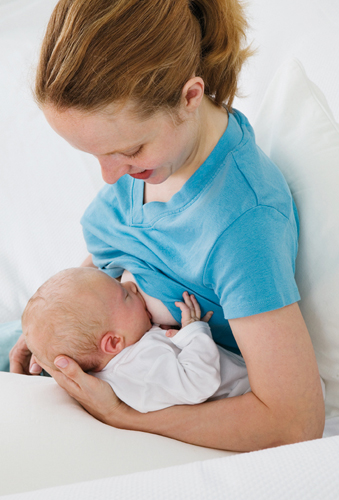Although breastfeeding is one of the most natural
acts in the world, it can take a lot of practice before you get the hang
of it. Both you and your baby may be amateurs, so take your time to
become accustomed to different positions, and enjoy the experience.
Experiment with different positions—some
moms like the “cradle hold,” while others prefer the “crossover hold”
where they use the opposite arm and hand to hold the baby to the breast
they are feeding from Ask your pediatrician, OB, or a lactation consultant for advice about the many different breastfeeding positions, and experiment until both you and your baby are comfortable Regularly alternate breastfeeding holds—each
hold puts pressure on a different part of your nipple and you may find
that using different holds is the best way to avoid getting clogged milk
ducts Make sure your baby is facing you, usually lying on his side, rather than on his back You might find it easier if you put a footrest or low table under your feet, to offer more support and prevent having to bend over your baby Choose a comfortable chair with armrests, and use a pillow to support your back and arms Always bring your baby to your breast, rather than the other way around Use one hand to support your breast as you nurse Try swaddling your baby or gently holding his arms by his side to make nursing easier Alternate the breast you first feed from—not
only will your baby get the hydrating foremilk before moving on to the
rich, more nutritious hind milk, but you’ll ensure that both breasts
keep producing plenty of milk
Try to relax before feeding
Keep a tall glass of water or juice by your side to keep you hydrated, which helps you to produce milk Ensure that your baby latches on correctly—this is undoubtedly the secret of successful breastfeeding
Latching on
To help ensure a good latch,
hold your breast and touch your nipple to your baby’s nose; tickling
his cheek and lips with the nipple will encourage the “rooting reflex,”
sending a signal to your baby to open his mouth Your baby’s mouth needs to be open wide, with his tongue down and forward, and your nipple should be aimed at the roof of his mouth He should be drawing all of the nipple and some breast tissue into his mouth, his lower lip will be rolled out, and his chin will be against your breast When your baby is correctly latched on,
you should hear only a low-pitched swallowing noise—not a sucking or
smacking noise—and you should see his jaw moving, a sign that successful
feeding is taking place To remove your child from the breast,
carefully insert your clean little finger into the corner of his
mouth—a gentle “pop” means you’ve broken the suction and you can pull
him away



|